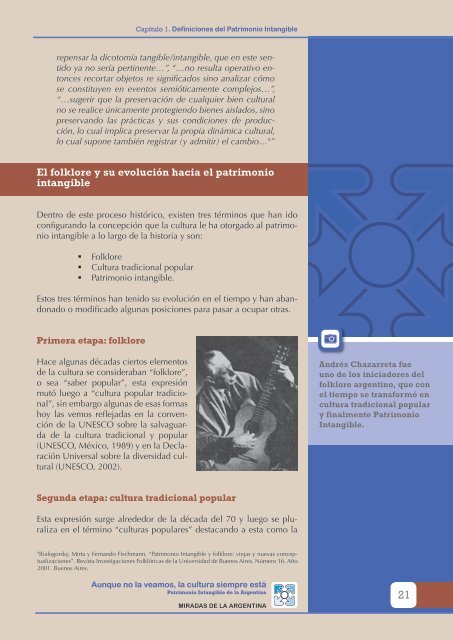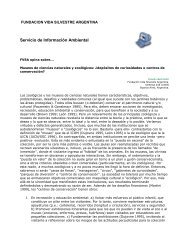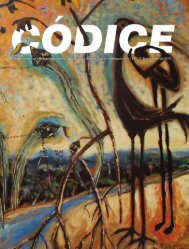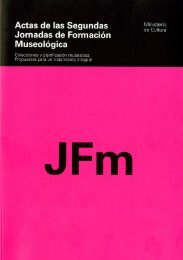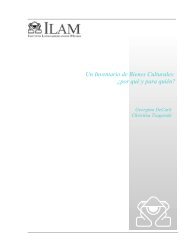Aunque no la veamos, la cultura siempre está Carlos ... - Ilam
Aunque no la veamos, la cultura siempre está Carlos ... - Ilam
Aunque no la veamos, la cultura siempre está Carlos ... - Ilam
You also want an ePaper? Increase the reach of your titles
YUMPU automatically turns print PDFs into web optimized ePapers that Google loves.
Capítulo 1. Definiciones del Patrimonio Intangible<br />
repensar <strong>la</strong> dicotomía tangible/intangible, que en este sentido<br />
ya <strong>no</strong> sería pertinente…”, “…<strong>no</strong> resulta operativo entonces<br />
recortar objetos re significados si<strong>no</strong> analizar cómo<br />
se constituyen en eventos semióticamente complejos…”,<br />
“…sugerir que <strong>la</strong> preservación de cualquier bien <strong>cultura</strong>l<br />
<strong>no</strong> se realice únicamente protegiendo bienes ais<strong>la</strong>dos, si<strong>no</strong><br />
preservando <strong>la</strong>s prácticas y sus condiciones de producción,<br />
lo cual implica preservar <strong>la</strong> propia dinámica <strong>cultura</strong>l,<br />
lo cual supone también registrar (y admitir) el cambio… 9 ”<br />
El folklore y su evolución hacia el patrimonio<br />
intangible<br />
Dentro de este proceso histórico, existen tres térmi<strong>no</strong>s que han ido<br />
configurando <strong>la</strong> concepción que <strong>la</strong> <strong>cultura</strong> le ha otorgado al patrimonio<br />
intangible a lo <strong>la</strong>rgo de <strong>la</strong> historia y son:<br />
�<br />
�<br />
�<br />
Folklore<br />
Cultura tradicional popu<strong>la</strong>r<br />
Patrimonio intangible.<br />
Estos tres térmi<strong>no</strong>s han tenido su evolución en el tiempo y han abandonado<br />
o modificado algunas posiciones para pasar a ocupar otras.<br />
Primera etapa: folklore<br />
Hace algunas décadas ciertos elementos<br />
de <strong>la</strong> <strong>cultura</strong> se consideraban “folklore”,<br />
o sea “saber popu<strong>la</strong>r”, esta expresión<br />
mutó luego a “<strong>cultura</strong> popu<strong>la</strong>r tradicional”,<br />
sin embargo algunas de esas formas<br />
hoy <strong>la</strong>s vemos reflejadas en <strong>la</strong> convención<br />
de <strong>la</strong> UNESCO sobre <strong>la</strong> salvaguarda<br />
de <strong>la</strong> <strong>cultura</strong> tradicional y popu<strong>la</strong>r<br />
(UNESCO, México, 1989) y en <strong>la</strong> Dec<strong>la</strong>ración<br />
Universal sobre <strong>la</strong> diversidad <strong>cultura</strong>l<br />
(UNESCO, 2002).<br />
Segunda etapa: <strong>cultura</strong> tradicional popu<strong>la</strong>r<br />
Esta expresión surge alrededor de <strong>la</strong> década del 70 y luego se pluraliza<br />
en el térmi<strong>no</strong> “<strong>cultura</strong>s popu<strong>la</strong>res” destacando a esta como <strong>la</strong><br />
9 Bialogorsky, Mirta y Fernando Fischmann. “Patrimonio Intangible y folklore: viejas y nuevas conceptualizaciones”.<br />
Revista Investigaciones Folklóricas de <strong>la</strong> Universidad de Bue<strong>no</strong>s Aires, Número 16. Año<br />
2001. Bue<strong>no</strong>s Aires.<br />
<strong>Aunque</strong> <strong>no</strong> <strong>la</strong> <strong>veamos</strong>, <strong>la</strong> <strong>cultura</strong> <strong>siempre</strong> <strong>está</strong><br />
Patrimonio Intangible de <strong>la</strong> Argentina<br />
MIRADAS DE LA ARGENTINA<br />
Andrés Chazarreta fue<br />
u<strong>no</strong> de los iniciadores del<br />
folklore argenti<strong>no</strong>, que con<br />
el tiempo se transformó en<br />
<strong>cultura</strong> tradicional popu<strong>la</strong>r<br />
y finalmente Patrimonio<br />
Intangible.<br />
21


